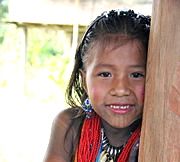Panamanian Americans

History of Panama
On the XVI Century, Spain had turned Panama into a route of crossing between the seas and into an important commercial center within its empire. Spain transported there its wealth to be distributed to their colonies in the pacific coast of America. That concentration of wealth attracted pirates and privateers like the famous pirate Francis Drake and Henry Morgan. Motivated by airs of freedom of the neighboring countries, Panama became independent from Spain in the month of November of 1821, to be united to the countries of the Great Colombia, conformed by Colombia, Venezuela and Ecuador. Nevertheless, Panamanian desire to become a free republic managed to come through and Panama was separated from Colombia in the third day of November in 1903.
 Since 1820, more than one million immigrants from Central and South America migrated to the United States. Until 1960, the U.S. Census Bureau did not produce statistics that separated the Panamanian immigrants, the South Americans and Central Americans. The Panamanian Americans increased slowly in the United States. Since the 1830’s, only 44 arrivals were recorded in this country, by the early twentieth century more than 1,000 came annually. After World War II the flow of immigrants from Panama remained small even though there were no immigration restrictions on the people from the Western Hemisphere.
Since 1820, more than one million immigrants from Central and South America migrated to the United States. Until 1960, the U.S. Census Bureau did not produce statistics that separated the Panamanian immigrants, the South Americans and Central Americans. The Panamanian Americans increased slowly in the United States. Since the 1830’s, only 44 arrivals were recorded in this country, by the early twentieth century more than 1,000 came annually. After World War II the flow of immigrants from Panama remained small even though there were no immigration restrictions on the people from the Western Hemisphere.
However, the Panamanian immigration increased dramatically after the 1965 Immigration Act, which imposed a ceiling of 120,000 admissions from the hemisphere. Its increase immigration was such that by 1970, Panamanians were able to be one of the largest of the Central American groups in the United States. Most Panamanians that came were nonwhites and most were women. It could register that the number of immigrant males per 100 females was very low in the 1960s, falling to 51 for Panama.
Many the female immigrants worked of in service, domestic, or low-paid, white-collar workers who immigrated to earn money to, in return, send home. Since 1962 the percentage of employed newcomers who are domestic servants has remained high, ranging from 15 to 28 percent. The entry of homemakers and children after 1968 was eased by the immigration preference system favoring family reunions. They had already approximated 86,000 people of Panamanian ancestry living in the United States.



